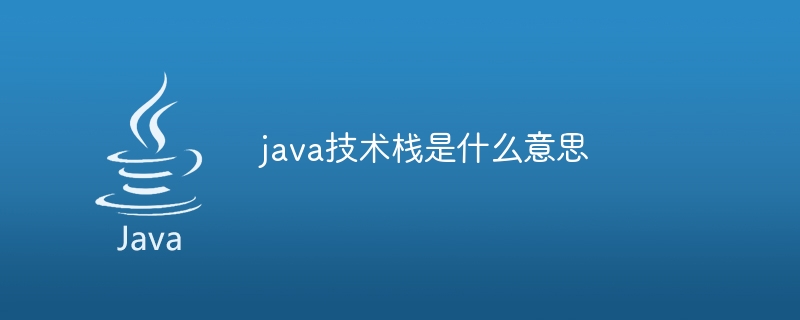
The Java technology stack refers to a collection of related technologies required to complete an application or project. The Java technology stack includes: 1. Java programming language; 2. Java virtual machine; 3. Java class library; 4. Java platform; 5. Java framework; 6. Java tools; 7. Java security; 8. Java multi-threaded programming ; 9. Java network programming; 10. Java application server. Mastering the Java technology stack can help developers better cope with various application scenarios and needs, and improve development efficiency and quality.

The operating system for this tutorial: Windows 10 system, DELL G3 computer.
The Java technology stack refers to a collection of related technologies required to complete an application or project. These technologies include the Java programming language itself, Java Virtual Machine (JVM), Java class libraries, Java frameworks, Java tools, etc. These technologies cooperate with each other to form a complete technical system to help developers efficiently develop, deploy and manage Java applications.
Specifically, a typical Java technology stack may include the following:
1. Java programming language: The Java programming language is the foundation of the Java technology stack and provides Object-oriented programming model, rich data types and API library.
2. Java Virtual Machine (JVM): JVM is one of the cores of Java technology and is responsible for executing Java bytecode so that Java programs can run on any device that supports JVM.
3. Java class library: The Java class library provides a rich set of standard libraries and third-party libraries, including functions such as collections, input/output streams, database access, and network programming.
4. Java platform: Includes different versions such as Java SE (Standard Edition), Java EE (Enterprise Edition) and Java ME (Micro Edition), which are suitable for different application scenarios.
5. Java framework: Software architecture used to simplify Web application development, such as Spring, Struts, Hibernate, etc.
6. Java tools: Tools used to develop, test, debug and deploy Java applications, such as Eclipse, IntelliJ IDEA and other integrated development environments (IDEs), Maven, Gradle and other builds Tools, unit testing frameworks such as JUnit.
7. Java security: Includes access control, identity authentication, data encryption and other functions to protect Java applications from security threats.
8. Java multi-threaded programming: Supports multi-threaded programming, and can perform concurrent operations through threads to improve program execution efficiency.
9. Java network programming: Supports TCP/IP and UDP/IP protocols to facilitate developers to develop network applications.
10. Java application server: Server platform used to deploy and manage Java applications, such as Tomcat, Jetty, GlassFish, etc.
These technologies cooperate with each other to form a complete Java technology stack, helping developers to efficiently develop, deploy and manage Java applications. According to specific application scenarios and needs, suitable technologies can be selected and combined to achieve the best development results.
For beginners, learning the Java technology stack requires gradually mastering various technical points and understanding the connections and cooperation between them. You can learn and understand the Java technology stack in depth by reading relevant books, participating in training courses, and practicing projects. At the same time, paying attention to the dynamics of the Java community and technology development trends, and promptly following up on new technologies and tools are also important ways to stay ahead of the technology curve.
In short, the Java technology stack is a complete technology system, including various technologies from basic languages to advanced frameworks and application servers. Mastering the Java technology stack can help developers better cope with various application scenarios and needs, and improve development efficiency and quality.
The above is the detailed content of What does java technology stack mean?. For more information, please follow other related articles on the PHP Chinese website!
